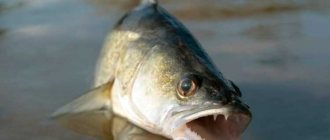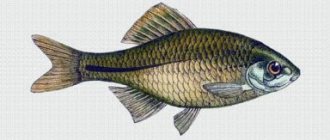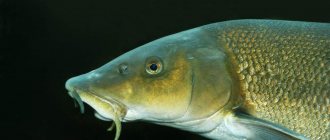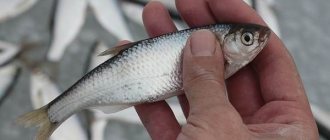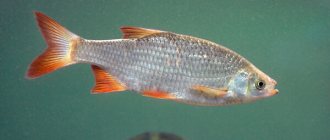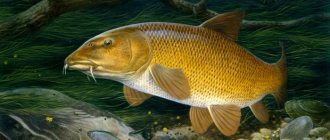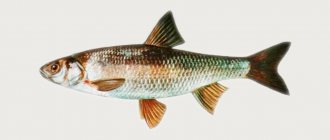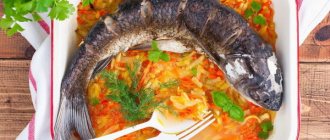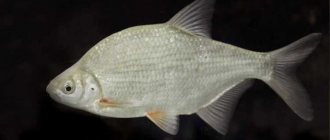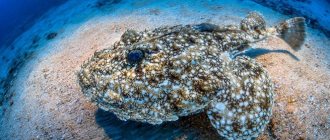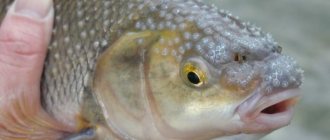Greenfinch, or rulena, or lapina (Peacock wrasse) lives in the Mediterranean Sea and the adjacent waters of the Atlantic Ocean. Length up to 25-30 cm, weight up to 290 g. Usually found in coastal areas of the sea among rocks and stones overgrown with algae. Reaches sexual maturity at 1-2 years of age. Spawning in spring and summer. The nests are built from algae and have a round or oval shape. Life expectancy is up to 14-15 years. It feeds on small bivalves.
Appearance of greenfinch
The body is oblong, laterally compressed, covered with cycloid scales. The dorsal fin is long, with a shorter soft part. The anal fin is slightly longer than the soft part of the dorsal fin, with three spines. The caudal fin is rounded. The snout is pointed, elongated; the mouth is small, moderately retractable; there are 6-9 folds on the lips; the jaws have fairly strong canine-shaped single-row teeth. The dorsal fin has 14-17 spiny rays and 9-12 soft ones, the anal fin has 3 spiny rays and 8-12 soft ones.
The scales on the body are relatively large, while those on the head are smaller. On the cheeks between the eye and the preopercular bone (3) there are 4-5 rows of scales overlapping one another, extending in one row behind the eye; 2-4 rows of small anterior and 1-2 rows of larger posterior scales on the interopercular bone; The roof bone is entirely covered, with the exception of sometimes a small space at the posterior edge, with 4 rows of scales on top and 2 below.
Related article Quail wrasse (Symphodus roissali)
Fish Wrasse - Greenfinch
Home ❱
Flora and fauna
❱
Fishes of the Black Sea
❱
Fish Wrasse - Greenfinch
The Black Sea cannot boast of the species richness of fish in its waters. Zelenushka is rightfully considered one of its famous and unusual inhabitants.
The greenfinch, or ocellated wrasse, is a small fish that lives in the coastal waters of the Black Sea. It is found off the coast of the Caucasus and Crimea. This is an unpretentious and hardy fish that leads a bottom-dwelling lifestyle. It has no commercial significance.
Short description
Wrasse is a small fish, barely 25 centimeters long. An adult weighs about 500 grams.
The body of the greenfinch is oblong, flattened laterally.
The fins are long, with a small soft part. The tail has a rounded shape.
The head is big. The growth is small, with fanged teeth in one row, the lips are thick with folds on the inner surface.
The coloring of young animals and females is discreet: they are gray-green with a silvery sheen on the belly. The color of males is much brighter, especially during the spawning period. The body is blue-green to green-yellow in color, with bright red stripes along it. The top of the head turns blue. Spots and stripes of yellow, red, blue, and light blue appear on the fins.
Habitats
The greenfinch lives in the Atlantic Ocean from Morocco to northern Spain. It is found in the Black and Mediterranean Seas, in the western part of the Azov coast.
Wrasses live in small schools near the rocky bottom and stones overgrown with aquatic vegetation. Less commonly observed in sandy lagoons. They do not migrate for the winter, but only go deeper.
Nutrition
They feed on invertebrate bottom organisms, crustaceans and worms. The shells are ground with strong teeth located in the throat. Eats plant foods.
Reproduction
Puberty in wrasses occurs early: at 12-18 months, as soon as the female reaches 10 centimeters in length. Spawning takes place from May to August. In thickets on sandy or stone soil, a large male builds a special nest. It has the shape of a saucer. The wrasse itself guards the house and takes care of it. The female lays up to 6,000 larvae on steep walls. Behind her, the next partner spawns in the same nest. The development of fry lasts from 4 to 8 days.
You might be interested
- Black Sea mullet
Black Sea mullet
- Black Sea garfish
Black Sea garfish
- Blenny
Blenny
- bluefish
bluefish
Noticed an error or irrelevant information? Please inform
us about this
send a message
Send Cancel
Color
The color of the greenfinch is extremely variable. The ground color of the body and head is greenish or green, darker on the back and light or grayish on the belly. On the sides of the body, males have red spots in the form of two longitudinal stripes with sparser blue ones between them; females have brown, red and blue spots on the sides of the body; on the caudal peduncle under the lateral line at the base of the caudal fin there is a spot, darker, red in males, dark brown in females, sometimes vague and unclear; along the base of the dorsal and anal fins in males there is usually a stripe of smaller red spots in even smaller blue ones; larger blue spots are present above the red ones along the anal fin, between the anal and pelvic fins and on the lower part of the caudal peduncle.
On the head of the greenfinch there are smaller and sparse red spots, which are absent in females. The lower part of the dorsal and anal fins is green or greenish, in males the upper part of both fins is red, darker between the branched rays, with 2-3 rows of blue spots on the soft part and one row on the spiny part of the dorsal, along the base and apex of the anal fin it is blue, lighter stripe, grayish in places, along the apex; the lower part of the caudal fin is greenish, the upper part is red with numerous and frequent blue spots; The coloring of the dorsal, anal and caudal fins in females is less bright, the blue spots are lighter, and in places grayish.
The pectoral fins are yellow, lighter in females; The ventrals of males are blue with red spots or stripes between the rays, and those of females are light green with brown spots.
Description[edit | edit code]
The number of body rings (12) is 13-17, the number of tail rings is 36-41 (42-44). The greatest body length is 16 cm, weight is 1.20 g. Life expectancy is unknown. The body is very long and low, not compressed at the sides, with well-defined edges. There are dorsal, pectoral and anal fins. At the posterior end of the ridges of the scutes of the body and tail rings there are sharp spines, which together with the ridges makes the body, unlike other sea pipes, not only rough, but also prickly. There are at least 13 rings under the base of the dorsal fin. Both halves of the pectoral girdle are motionless, fused together, under them there is an unpaired abdominal plate, the anterior (upper) edge of both halves of the girdle is smoothly rounded. The snout is long, trunk-shaped, low, somewhat laterally compressed, its length is on average 58-61% of the length of the head. The eyes are large, convex, their diameter is more than twice the height of the snout. The color of the back is dark, grayish-bluish, with transverse black stripes, the sides of the body and the gill cover are grayish-silver, silvery. The belly is milky silver or silvery.
Reproduction of greenfinch
The nests are built from algae and have a round or oval shape, 10-20 cm in diameter. Several females lay eggs in one nest; males guard the clutches. The fertility of females 175-260 mm long is 12390-57847 eggs. The eggs, like those of other species of the genus, are bottom-spawned and are laid out in several, 3-4 portions. Embryonic development under temperature conditions close to natural lasts 121-200 hours, in the Mediterranean Sea it is half as long - 4 days. Fry in Novorossiysk Bay are caught throughout the winter.
Reproduction
Spawning occurs at the end of spring and the first third of summer. The eggs are bottom-based and sticky.
Shortly before the start of spawning, the male's design talent awakens. He begins to improve the territory where his children will be born. The nest has an oblong shape and a flat bottom.
Dad puts there fragments of shells and flat stones that he finds nearby. The male carries everything he needs in his own mouth.
The eggs that appear stick to stones and shells, and a caring parent wraps them with scraps of algae on top so that no one covets his future offspring.
The courtship of greenfinches is very peculiar. Some males try to charm their girlfriends, but most often they, as they say, take the female unceremoniously. The wrasse, ready to start a family, furiously swarms in the nest, drives several females, beats them, tugs at their fins, until one of the finally intimidated ones agrees to accept these advances.
The nest is filled with unfertilized eggs; fertilization itself occurs after the male spawns milk.
Economic importance
The economic importance of greenfinch is small. It is not an object of special fishing; it is caught with amateur fishing gear - lifting nets, fishing rods, nets, etc. The meat is not of high taste quality.
Literature: 1. N. Svetovidov. Fishes of the Black Sea. Moscow-Leningrad, 1965 2. Vasilyeva E.D. Nature of Russia: animal life. Fish. - M.: LLC "Firm Publishing House ACT", 1999. - 640 p. 3. Vasilyeva E.D. Fishes of the Black Sea. Key to marine, brackish-water, euryhaline and anadromous species with color illustrations collected by S.V. Bogorodsky.- M.: Publishing house VNIRO, 2007 4. Commercial fish of Russia. In two volumes / ed. O.F.Gritsenko, A.N. Kotlyar and B.N. Kotenev. M.: publishing house VNIRO. 2006.- 1280 p. (Vol. 2 - 624 pp.).
Description of the common greenfinch
This bird is quite small in size, slightly larger than a sparrow. It can be easily recognized among others by its appearance, and most importantly, by its color. This small bird has a relatively large head and a powerful, very light beak. The tail is dark in color, short and narrow. The tips of the feathers are light yellow. Eyes are dark in color. The body is dense and elongated.
Appearance
The passerine family to which this bird belongs is a transitional link between buntings and common sparrows, to which it is similar in size and behavior. The size of an adult greenfinch is on average 14-17 cm, the wingspan is 18-20 cm, the bird weighs about 25-35 grams.
The common greenfinch has a rather large beak and a short pointed tail. The characteristic color of this small bird is: a yellow-green back, often with a brown stripe, which turns into dark wings and a gray tail with a bright lemon edging, a yellow breast with a greenish tint, and gray cheeks. The beak is thick, conical, gray, the lower jaw is red, the iris and legs are brown.
Lifestyle, behavior
Common greenfinches are quiet and quiet birds that rarely vocalize. As a rule, they prefer to stay alone, less often in pairs or small groups in trees, bushes or fields of sunflowers, hemp and other agricultural crops. Adult birds usually feed on the ground. Greenfinch chicks are given exclusively plant food.
The basis of the diet of common greenfinch chicks is a variety of greens, weed seeds, cereals, previously soaked in the crop of an adult bird, and rarely - elm seeds. As a kind of food additive to plant foods, various insects and their larvae can sometimes be found. In mid-summer, common greenfinches often fly to summer cottages and gardens for serviceberry seeds, which they eat from the fruits without tearing them off.
Lifespan
If you keep the common greenfinch in captivity, its life expectancy will be up to 15 years. This is due to the absence of natural enemies, comfortable living conditions, as well as regular and high-quality nutrition. In nature, the common greenfinch lives on average from 7 to 10 years.
